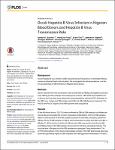Occult Hepatitis B Virus Infection in Nigerian Blood Donors and Hepatitis B Virus Transmission Risks
Oluyinka, Opaleye O.
Tong, Hoang Van
Tien, Sy Bui
Fagbami, Ademola H.
Adekanle, Olusegun
Ojurongbe, Olusola
Bock, Thomas
Kremsner, Peter G.
Velavan, Thirumalaisamy P.
Background: Occult hepatitis B virus infection (OBI) characterized by the absence of detectable HBsAg remains a potential threat in blood safety. We investigated the actual prevalence, viral factors and genotype of OBI infections in Nigerian blood donors. Methods: Serum collected from two blood banks were reconfirmed as HBsAg seronegative by ELISA. Forty HBsAg positive samples were employed as controls. HBV-DNA was amplified from all donors and viral loads were determined using quantitative real-time PCR. Antibodies to the HBV core, surface and HBe antigen (anti-HBc,anti-HBs,HBeAg) were measured. The PreS/S and PreC/C regions of the HBV genome were sequenced. Results: Of the 429 blood donors, 72(17%) were confirmed as OBI by DNA detection in different reference labs and excluded the concern of possible contamination. Of the 72 OBI samples, 48(67%) were positive for anti-HBc, 25(35%) positive for anti-HBs, and 2(3%) positive for HBeAg. Of the 72 OBI samples, 31(43%) were seropositive for either anti-HBc, anti-HBs or HBeAg, 21 (30%) positive for both anti-HBc and anti-HBs,one positive for both anti-HBc and HBeAg. None of the OBI samples were positive for all three serological markers. The viral load was
Dateien zu dieser Publikation
Keine Lizenzangabe
Verwandte Publikationen
Anzeige der Publikationen mit ähnlichem Titel, Autor, Urheber und Thema.
-
2013-10-18ZeitschriftenartikelHigh Prevalence and Significance of Hepatitis D Virus Infection among Treatment-Naïve HBsAg-Positive Patients in Northern Vietnam Sy, Bui Tien; Ratsch, Boris A.; Toan, Nguyen Linh; Song, Le Huu; Wollboldt, Christian; Bryniok, Agnes; Nguyen, Hung Minh; Luong, Hoang Van; Velavan, Thirumalaisamy P.; Wedemeyer, Heiner; Kremsner, Peter G.; Bock, ThomasBackground: Hepatitis D virus (HDV) infection is considered to cause more severe hepatitis than hepatitis B virus (HBV) monoinfection. With more than 9.5 million HBV-infected people, Vietnam will face an enormous health ...
-
2012-01-25ZeitschriftenartikelComparative hepatitis A seroepidemiology in 10 European countries Kurkela, S.; Pebody, Richard; Kafatos, G.; Andrews, Nick; Barbara, C.; Bruzzone, B.; Butur, D.; Caplinskas, S.; Davidkin, I.; Hatzakis, Angelos; Hellenbrand, Wiebke; Hesketh, L. M.; Nardone, A.; Nemecek, V.; Pistol, A.; Sobotová, Z.; Vranckx, R.; Anastassopoulou, C. G.The WHO recommends hepatitis A virus (HAV) immunization according to level of transmission and disease burden. We aimed to identify susceptible age groups by standardized serosurveys to inform HAV vaccination policy in ...
-
2015-11-11ZeitschriftenartikelHepatitis E Virus Superinfection and Clinical Progression in Hepatitis B Patients Hoan, Nghiem Xuan; Tong, Hoang Van; Hecht, Nicole; Sy, Bui Tien; Marcinek, Patrick; Meyer, Christian G.; Song, Le Huu; Toan, Nguyen Linh; Kurreck, Jens; Kremsner, Peter G.; Bock, Thomas; Velavan, Thirumalaisamy P.Hepatitis E virus (HEV) infection may cause acute hepatitis and lead to hepatic failure in developing and developed countries. We studied HEV seroprevalences in patients with hepatitis B virus (HBV) infection to understand ...

